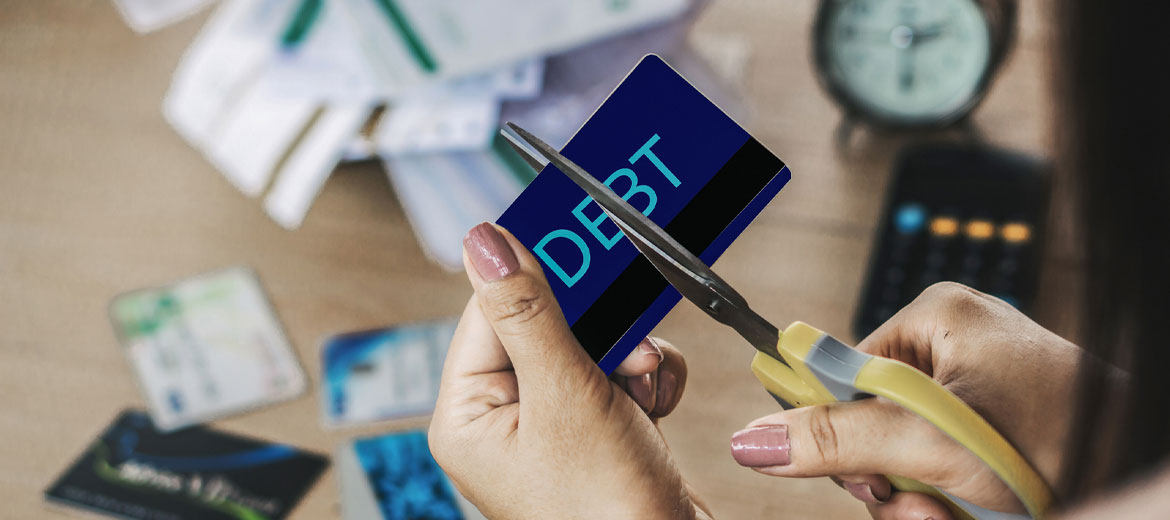
6 STEPS TO BE DEBT FREE
By: Aubrey Love
Of all the four-letter words out there, “debt” is the one we most often shy away from. It’s a topic that most of us try to avoid, but inevitably, we must face the reality of it someday. In this blog, we will discuss some common-sense approaches to becoming debt free, or at least really close to it.
Step 1: Face Your Debt
If you are serious about becoming debt free, then you must face the reality of your total debt. Not just the parts you want to pay down, but all your debt. Debt can be broken down into three primary categories, revolving loans, installment loans and general living expenses. Unfortunately, we can not escape the third category, general living expenses. This type of debt will include utilities, taxes, etc. However, the other two categories, revolving loans and installment loans can be dwindled down to nothing or next to nothing with proper planning and plan execution.
Let’s first look at the difference between revolving loans and installment loans. Revolving loans, such as credit cards and revolving lines of credit, are loans that will always have an outstanding balance and a continuous line of credit. Installment loans are a one time shot loan, such as mortgages, car loans, student loans, etc.
It’s best to list all your debt in a spreadsheet or financial tracking tool. Make sure to include any interest that may be accrued during your debt payoff period.
Step 2: Set Your Baseline Budget
Earlier, you listed all your debt, in this stage you need to list all your income. This will include revolving income such as paychecks from your job and any income you expect to receive for one-off jobs you may have scheduled. Don’t forget to include any windfalls you expect to receive during your debt repayment timeframe. This will include tax refunds, bonuses, etc. Add these amounts in your spreadsheet or financial tracking tool where you listed your debts.
Step 3: Pick a Debt Repayment Plan
The two most common methods of debt repayment are the snowball and avalanche methods. Both have their pros and cons and those can vary depending on the type of person you are.
The snowball approach lets you tackle the smallest debts first and you have a more immediate gratification knowing that you are well on your way to becoming debt free.
With the avalanche method, you pay off the debts with the highest APR first. This can save you a substantial amount of money but there may be a little longer wait on the gratification from paying this debt off.
A variation of these two methods is called a reverse snowball. This is when you pay off the highest balance regardless of the APR. That first gratification experience might be a long time away, but once it’s paid down, the rest go relatively quicker each time.
Step 4: Manage Your Money
Once you have established your baseline budget, debt vs income, you can plan out how much discretionary income you have to work with. Discretionary income is broken down as: what you bring in minus what you need to live on. That remaining balance is your discretionary income.
You should split the discretionary income into two piles, spending money and debt repayment. Don’t cut yourself short on the spending money, but make sure your primary focus is on the debt repayment. Remember, the more you pay toward your debt, the faster you get out of debt.
You may find that you have $500 per month in discretionary income that you split as $200 for spending money and $300 for debt repayment. What ever split you decide on, stick with it through the course of your debt repayment process.
Step 5: Save on Interest
As mentioned earlier, some of your credit cards may carry a high interest rate. Try to transfer those outstanding debts to a card that offers 0% APR for the first year or longer. This will buy you some time to pay them off while avoiding those inflated interest payments.
Once you have some of these higher interest cards paid off, you can apply that freed up amount to your remaining debt. Where you had $300 to use, you may now have $400 to apply to your debt each month.
Step 6: Work Your Plan
Plan your work and work your plan. — Napoleon Hill
Napoleon Hill was wise in this statement, plan your work and work your plan. Like anything in life, we need a plan to carry us through the completion of any task. Once you have your plan in place, stick with it no matter how tough it gets. If you just absolutely need to suspend your plan for a month or two, then do so and get right back to it as soon as possible. Yes, there will be some sacrifices that you will have to endure but keep your eye focused on the long-term goal and never give up.
Final Thoughts:
There is no reason anyone can’t get out of debt with some hard work and dedication. Once you are out of debt, or close to it, consider keeping a portion of your plan in place to keep from getting in over your head again. You may also consider taking on some part time gigs to help pay down your debt. These simple side hustles can be short or long term.
Disclaimer: The information posted on blogs and vlogs by City National Bank is for educational and entertainment purposes only and is not intended as a substitute for professional or legal advice. City National Bank will not be held liable for any loss or damage of any kind in connection with this blog.